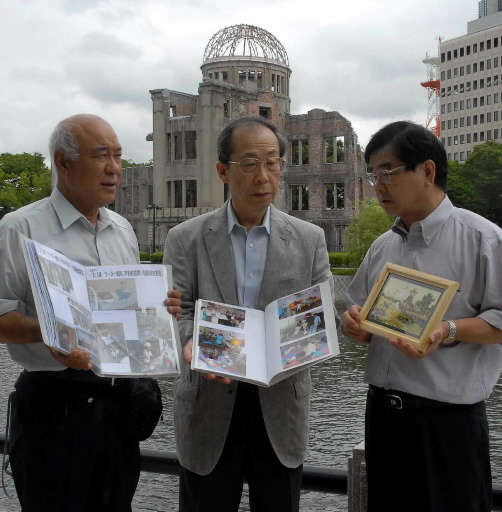Vietnam: 50 years after the use of defoliants, Part 3: Path to a solution, Article 4
Jul. 25, 2012
Article 4: Exchanges at grass roots-level
Scope of relief activities widens
by Takamasa Kyoren, Staff Writer
Collaboration with association and participation in events
In mid-July, just a few weeks before the anniversary of the atomic bombing, three men who have been involved with Vietnam over the years met in Hiroshima Peace Memorial Park.
Hiroshima resident Shinichi Onaka, 62, is the son of an atomic bomb survivor. “I really hope they can make use of this,” he said as he gave a photograph of the A-bomb Dome to Tatsuo Akagi, 60, a resident of Higashi Hiroshima and executive director of the Hiroshima Vietnam Peace and Friendship Association (HVPF). The photo, which shows the dome with cherry blossoms in full bloom, will be used as the basis for a needlepoint work to be created by young Vietnamese victims of defoliants who receive support from the HVPF.
About 10 years ago Mr. Onaka invited members of a Vietnamese peace group working toward the abolition of nuclear weapons to his home. In the course of their ongoing exchanges, Mr. Onaka learned about the reality of the effects of defoliants in the spring of last year. He subsequently visited Lang Hoa Binh (Peace Village) in Ho Chi Minh City. He was moved by the silent suffering of the young people there, which reminded him of the atomic bomb survivors. In February of this year he visited the young people again.
Group from Hiroshima to visit
A four-member group from the Hiroshima-Vietnam Association will visit the Peace Village again in August. “I’d like to ask them what we can do about the effects of defoliants,” said Tatsuya Hayashi, 72, the association’s president. “We must not neglect the people who were harmed by the war.” The group will also pay its first visit to the Ho Chi Minh City Association for Victims of Agent Orange/Dioxin and deliver aid money.
Mr. Hayashi, who was born in the Philippines during that country’s wartime occupation by Japan, is well acquainted with the pain of war. As a young boy he was terrified by air raids, and after Japan’s defeat his family was confined in an American prison camp. Following their return to Japan they lived in poverty. Mr. Hayashi later met a Vietnamese man who had been orphaned by the war and was living in Hiroshima. Mr. Hayashi has offered him support. Even now the man is like a member of their family, Mr. Hayashi said.
Yoichi Nishimura, 69, a former high school teacher who lives in on Awaji Island in Hyogo Prefecture, is another person who has worked to support the victims of defoliants. While addressing environmental issues he became interested in the issue of dioxin contamination, and in 2001 he visited the Peace Village for the first time. After his retirement in 2004, he taught Japanese and other subjects to young people in the Peace Village as a volunteer for about three and a half years. When a girl who was born without legs below the knees passed the high school entrance exam, Mr. Nishimura was overjoyed.
But he learned that there were many other young people who were bedridden with serious disabilities and could not come to the Peace Village to receive care. He traveled around Vietnam photographing them, feeling he had to let people know about their plight. In 2009 he published a collection of his photographs.
This summer he became acquainted with Mr. Akagi of the HVPF. “We can’t contribute in the same ways, but I was encouraged to find that there was someone out there with the same feelings,” he said.
Examining effects through film
Last year’s 50th anniversary of the use of defoliants inspired other new projects. Nine years ago film director Masako Sakata, 64, a resident of Gunma Prefecture, lost her husband, an American veteran of the Vietnam War. Last year she completed “Living the Silent Spring,” her second documentary examining the effects of defoliants.
On August 10, Agent Orange Day in Vietnam, citizens’ groups and others will hold Vietnam Dioxin Day in Tokyo to call for relief measures. This is the second year the event will be held in Tokyo. Ms. Sakata, who will participate in a panel discussion, is hopeful about the future. “We have established ties between the victims and those who want to offer their support, all of whom come from various backgrounds,” she said.
Continued interest in the victims’ plight and strengthened ties between people will provide the driving force for the relief effort. People must be made aware of the foolhardiness of the use of chemical weapons, and the resolve to eliminate them must be carried on by the next generation.
(This is the last article in this series.)
(Originally published on July 21, 2012)








